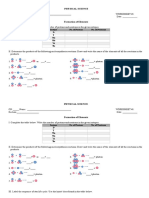Is 7752 1 1975
Is 7752 1 1975
Uploaded by
vijay_raina3114Copyright:
Available Formats
Is 7752 1 1975
Is 7752 1 1975
Uploaded by
vijay_raina3114Original Title
Copyright
Available Formats
Share this document
Did you find this document useful?
Is this content inappropriate?
Copyright:
Available Formats
Is 7752 1 1975
Is 7752 1 1975
Uploaded by
vijay_raina3114Copyright:
Available Formats
Disclosure to Promote the Right To Information
Whereas the Parliament of India has set out to provide a practical regime of right to
information for citizens to secure access to information under the control of public authorities,
in order to promote transparency and accountability in the working of every public authority,
and whereas the attached publication of the Bureau of Indian Standards is of particular interest
to the public, particularly disadvantaged communities and those engaged in the pursuit of
education and knowledge, the attached public safety standard is made available to promote the
timely dissemination of this information in an accurate manner to the public.
!"#$%&# '(%)
!"# $ %& #' (")* &" +#,-.
Satyanarayan Gangaram Pitroda
Invent a New India Using Knowledge
/0)"1 &2 324 #' 5 *)6
Jawaharlal Nehru
Step Out From the Old to the New
7"#1 &" 8+9&"), 7:1 &" 8+9&")
Mazdoor Kisan Shakti Sangathan
The Right to Information, The Right to Live
!"# %& ;<" =7"#" > 72 &(: ?0)"@" #AB 7" <&*" A*
Bhart+hariN,ti-atakam
Knowledge is such a treasure which cannot be stolen
IS 7752 (Part 1) (1975, Reaffirmed 2006): Guide for
Improvement of Power Factor in Consumers Installations,
Part 1: Low and Medium Supply Voltages. UDC
621.316.727.027.2
IS: 7752 ( Part I ) - 1975
. (Reaffirmed 2006)
Indian Standard
GUIDE FOR IMPROVEMENT OF POWER
FACTOR IN CONSUMERS'
INSTALLATIONS
Gr 4
PART I LOW .AND MEDIUM SUPPLY VOLTAGES
(Sixth Reprint DECEMBER 2007)
UDC 621.316.727.027.2
Copyright 1975
BUREAU OF INDIAN STANDARDS
MANAK BHAVAN, 9 BAHADUR SHAH ZAFAR MARG
NEW DELHI 110002
December 1975
;,
IS: 7752 (Part I) - 1975
Indian Standard
GUIDE FOR IMPROVEMENT OF POWER
FACTOR IN CONSUMERS'
INST ALLATIONS
PART I LOW AND MEDIUM SUPPLY VOLTAGES
Code of Practice for Power Install,ation and Maintenance Sectional
Committee; ETDC 20
Chairman Representing
SHRI K. S. SUBRAHIofANYAIof Central Electricity Authority, New Delhi
Members
SHRI N. S. S. AROKIASWAMY Tamil Nadu Electricity Board, Madras
SHRI N. TYAGARAJAN (Alternate)
SHRI V. G. BAPAT Electrical Engineer to the Government of Maha-
. rashtra, Bombay
SHRI B. L. DESHP ANDE (Alternate )
SHRI V. S. BHATIA Siemens India Ltd, Bombay
SHRI M. A. NOORUDIN (Alternate)
SHRI K. K. BOSE The Calcutta Electric Supply Corporation Ltd,
Calcutta
SHRI A. CHATTERJEE (Alternate)
SHRI N. N. CHAKRABORTY Government of West Bengal, Calcutta
SHRI K. V. CHAUBAL Federation of Electricity Undertakings of
Bombay
SHRI B. C. AMIN (Alternate) .
SHRI RANES RAY CHAUDHURI Engineering Construction Corporation Ltd, Bombay
SHRI L. E. Do' CRUZ ( Alternate)
CHIEF ENGINEER (ELECTRICITY) Mysore State Electricity Board, Bangalore
GENERAl!" .
CHIEF EimCTRICAL ENGINEER, Railway Board (Ministry of Railways), New Delhi
NORTHERN RAILWAY
DEPUTY DIRECTOR STANDARDS
(ELECTRICAL II, RDSO) (Alternate)
SHRI H. M. DESAI The Bombay Electric Supply and Transport Under-
taking, Bombay
SHRI D. M. VATCHA ( Alternate)
DIRECTOR (HED I) Central Electricity Authority, New Delhi
DEPUTY DIRECTOR ( HED I ) (Alternate)
SHRI K. K. GUPTA Jyoti Liinited, Baroda
SHRI K. W. DHARIofADHIKARI (Alternate),
( COlllillued on page 2 )
@ Copyright 1975
BUREAU OF INDIAN STANDARDS
This publication is protected under the Indian Copyright Act (XIV of 1957) and
reproduction in whole or in part by any means except with written.permissio.n of the
shall be. deemed to be an of copyright under the said Act.
IS : 7752 (Part I) 1975
( Continued/rom page 1 )
Members
SHRI MOHAMED HAMEED
SHRI R. T. HARIHAR
SHRIR. D.JAIN
SHRI V. A. KRISHNAMURTHI
SHRI A. RAJAGOPAL (Alternate)
SHRI V. G. KULKARNI
SHRI R. C. BAJPAI( Alternate)
SHRI.T. D. MALHOTRA
SHRI S. V. MARFATIA
SHRI M. L. MITTAL
SHRI K. C. LAHIRI (Alternate)
SaRI K. P. R, PILLAI
Represeltting
Chief Electrical Inspector to the Government of
Tamil Nadu, Madras
Maharashtra State Electricity Board, Bombay
Rural Electrification Corporation, New Delhi
Central Public Works Department, New Delhi
Tata Consulting Engineers, Bombay
Punjab State Eiectricity Board, Patiala
Tariff Advisory Committee (Insurance Association
of India), Bombay
Bharat Heavy Electricals Ltd, Bhopal
The Fact Engineering and Design Orp"anizatioft,
Udyogamandal
SHRI T. K. MATHEW VAIDYAN (Alternate)
SHRI S. S. RAGHAWAN Engineer-in-Chief's Branch, Army Headquarters,
New Delhi
SHRI K. N. NADGIR (Alternate)
SHRI1. C. SANGER Delhi Electric Supply Undertaking, Delhi
SHRI P. S. SAWHNEY (Alternate)
SrIRI SARDUL SINGH Chief Electrical Inspector to the Government of
Punjab, Patiala
SENIOR ASSISTANT TO CHIEF ELECTRICAL
INSPECTOR (Alter!late)
SaRI K. G. SHANMUKHAPPA NGEF Ltd, Bangalore
SaRI A. N. SRIVATHSA (Alternate)
DR T. C. SIDHAN Chief Electrical Inspector to the Government of
Kerala, Trivandrum
SHRI K, SUDHAKARAN NAIR Kerala State Electricity Board, Triv.andrum
SHRI R. A. SUBRAMONIA IYER (Alternate)
SHRI G. N. THADANI Engineers India Ltd, New Delhi
SHRI S. K. SHARMA ( Alternate)
SHRI N. SRINIVASAN, Director General, lSI (Ex-Offiqio Member)
Director ( Elec tecb )
Secretary
SHRI R. C.JAIN
Deputy Director (Elec tech ), lSI
IS : 7752 (Paa:t I) - 1975
Indian Standard
GUIDE FOR IMPROVEMENT OF POWER
FACTOR IN CONSUMERS'
INSTALLATIONS
PART I LOW AND MEDIUM SUPPLY VOLTAGES
o. FOR E W 0 R D
0;1 This Indian Standard (Part I) was adopted by the Indian Standards
Institution on 14 August 1975, after the draft finalized by the Code of
Practice for Power Installations and Maintenance Sectional Committee
had been approved by the E1ectrotechnical Division Council.
0.2 This standard ( Part I) has been prepared with a view to providing
guidance to the .. consumers of electrical energy who take supply at low and
medium voltage for improvement of power factor of the installations in
their preII.1ises. The subsequent" part of this standard will cover installa-
tions of consumers of electrical energy who take supply at hig4 voltage.
0.3 The various advantages of maintaining a high power factor of a system
reflects on the national economy of a country. The available resources are
utilized to its fullest possible extent. More useful power is available for
transmission and utilisation without any extra cost. Also the life ofindivi-
dual apparatus is considerably increased and tp.e energy losses reduced.
1. SCOPE
1.1 This standard ( Part I ) provides guidance to the consumers of electric
energy who take supply at low and medium voltages for improvement of
power factor of the installations in their premises.
2. TERMINOLOGY
2.1 For the purpose of this standard, the definitions given in IS: 2834-
1964* shall" apply.
~ GENERAL
3.1 Conditions of supply of .Electricity Boards or Licensees stipulate the
lower limit of power factor which is generally 085 an$1 consumer is obliged
.Specification for shunt capaciton Jor power sptems .
. 3
IS= 7752 (Part I) .1975
to improve and maintain the power factor of his installation to conform to
this conditions.
3.1.1 When the tariffs of Electricity Boards and the Licensees are based
on kVA demand or kW demand with suitable penalty/rebate for low/high
power factor, improvement in the power factor would effect savings in the
energy bills.
3.2 Power factor is dependant largely on consumers' apparatus and partly
on system components such as transformers, cables, transmission lines, etc.
System components have fixed paramefers of inductance, capacitance and
resistance. The choice of these components to bring up the power factor
depends on economics.
3.3 In case of ac supply, the total current taken by almost item of
electrical equipment, except that of incendescent lighting and most forms
of resistance heating, is made up pf two parts, namely:
a) the in-phase component of the current (active or useful current)
which is utilized for doing work or producing heat,'and
b) the quadrature c0mponent of the current (also called 'idle' or
, reactive' current) and used for creating magnetic field in the
machinery or apparatus. This component is not convertible
into useful output.
4. POWER FACTOR
4.1 The majority of ac electrical machines and equipment draw from the
supply and apparent power (kVA) which exceeds the required useful
power ( kW). This is due to the reactive power (kVAR) necessary for
alternating magnetic field. The ratio of useful power (kW) to apparent
power ( k V A ) is termed the power factor of the load. The reactive power
is indispensable and constitutes an additional demand on the system.
4:2 The power factor indicates the portion of the current in the system
pet:forming useful work. A power factor of unity ( 100 percent). denotes
100 percent utilisation of the total current for useful work whereas a power
factor of 0'70 shows that only, 70, percent of the curre,nt is performing useful
work. .
4.3 Economics of Power Factor Improvement
4.3.1' Static c'apacitors, also called static conde:dsers, 'when installed at or
near the point of consumption, provide necessary capacitive reactive power
and relieve distribution system before the point of its from
carrying the inductive reactive power to that extent. 1 " '.,
.' 4.rl.2.The use of static'capacitors is an econorpicalway, of improving
"power factor on- aCGount of their comparatively low cost,ease'ofinstaIJation,
less maintenance, low losses and the advantage of extension' by' additio
ll
of
. '1 '.' ... ',. ' : '. :-
IS , 7752 ( Part I) 1975
requlSlte units to meet the load growth. Installation of .capacitors also
improves the voltage regulatiqn and reduces amperes loading and energy
losses in the supply apparatus and lines.
4.3.3 When considering the economics connected with power factor
correction, . it is mOllt important to remembt:!r that any power factor
improving equipment will, in general, compensate for losses and lower
the loadings on supply equipment, that is, cables, transformers, switchgear,
generating plant, etc. .
4.3.4 The minimum permissible power factor prescribed in the condi-
tions of supply of Electricity Boards or Licensees and the reduction in
charges offered in supply tariffs for further improvement of power factor
shall, along with other considerations such as reduction of losses, etc, deter-
mine the. kVAR capacity of the capacitors to be installed.
4.3.5 In case of two part tariff with kV A demand charged, the value of
economic improved power factor ( Cos CP2) may be obtained ~ follows:
Let the tariff be Rs A per kV A of maximum demand per annum
plus Rs P per kWh
Cos CPl is the initial power factor,
COS CP2 is the improved.power factor after installing the capacitors
The economic power factor Cos CPt is obtained from the expression
Cos CPa = V I - !:
where
B is the total cost per k VAR per year of capacitor installation
inclusive of interest, depreciation and maintenance.
NOTE - The explanation for the derivation of the formula for economic power factor
Cos 4>'1. is given in Appendix A.
4.4 Principal Causes of Low Power Factor
4.4.1 The following electrical equipment and apparatus have a low
power factor:
a} Induction motors of all types particularly when they are
underloaded;
b) Power transformers and voltage regulators;.
c) Arc welders;
d) Induction furnaces and heating coils;
e) Choke coils and magnetic systems;
f) Fluorescent and discharge lamps, neon signs, etc.,
5
Ii, 7752 ( Part I ) 1975
4.4.2 The principal cause of a low power factor is due to the reactive
power flowing in the circuit. The reactive power depends on the inductance
and capacitance of the apparatus.
4.4.3 The relationship between the voltage and current and the effect of
use orc(1pacitor is expressed graphically as below:
c
v
01 == Load current
OC current
or == Total resultant line current
o V = Mains voltage
CPI = Angle of lag of current without capacitor
CP! = Angle of lag of current with capacitor
4.4.4 In the diagram, 0 V represents the mains voltage, and 01 the
current flowing in an inductive ac circuit such as one supplying a motor
or transformer .. The current vector 01 is displaced from the voltage vector
OV by the angle CPl' This is designated as the angle of lag of the current.
This angle increases as the inductance of the load circuit is increased.
The larger this angle of lag becomes, the lower is the power factor
of the circuit, the power factor beirig equal to the cosine of the angle of lag
( Cos CPI)' .
4.4.5 If now a capacitor is connected across the same circuit, it will
draw a current which leads the voltage in phase. This is represented by
vector DC drawn at 90
0
to 0 V since the capacitors take a leading current
of 90'0.
4.4.6 The resultant line current is the vector sum of the two currents 01
and OC which is the vector OT. Vector OT is smaller than vector 01
which means that the total curre:gtdrawn from the mains is reduced by
connecting the capacitor across the circuit. And since the angle of lag CP2
is smaller than CPl the Cos, CP2 is greater than Cos CPI' the power factor has
been improved by adding the capacitor.
4.5 Effect of Power Factor to Consumer
4.5.1 The disadvantages of low power faCtor areas follows:
a) Overloading of cables and transformers,
6
IS : 7752 (Part I ) 1975
b) Decresed line voltage at point of application,
c) Inefficient operation of plant, and
d) Penal power rates.
4.5.2 The advantages of high power factor are as follows:
a) Reduction in the current;
b) Reduction in power cost;
c) Reduced losses in the transformers and cables;
d) Lower loading of transformers, switch gears, cables, etc;
e) Increased capability of the power system (additional load can be
met without additional equipment);
f) Improvement in voltage conditions and apparatus performance;
and
g) Reduction in voltage dips caused by welding and similar equip-
ment.
5. USE OF CAPACITORS
5.1 In order to improve the power factor, the consumer shall install
capacitors where the natural power factor of his installation is low.
5.2 The average values of the power factor for different types of 3-phase
electrical installations as measured by one of the major utilities in the .
country is given in Table 1 for information.
5.2.1. The average values of power factors for electrical appliances and
equipment used on single phase supply are also given in Table 2 for
information.
5.3 Capacitors for power factor improvement may be arranged as described
in 6.4 to 6.7. The successful operation of power factor improvement
depends very largely on the positioning of the capacitor on the system.
Ideal conditions are achieved when the highest power factor is maintained
under all load conditions.
5.4 Individual Compensation - Wherever possible the should
be connected directly across the terminals of the low power factor appliance
or equipment. This ensures the control to be automatic through the same
switching devices of the apparatus or appliance.
5.5 Group Compensation - In industries where a large number of
small motors or other appliances and machines are installed and whose
opera tion is periodical it is economical to dispense with individual installa-
tion of capacitors. A bank of capacitors may be installed to connect them
to the distribution centre or main bus-bars of the group of machines. .
7
IS: 7752 ( Part I ) 1975
SL
No.
(1)
1.
2,
3,
4,
5,
6,
7,
8.
9,
10.
11.
12.
13.
14.
15.
16.
17.
18.
19.
20.
21.
22.
23,
24.
25.
26,
27.
28,
29.
30.
31.
32.
33;
34,
TABLE 1 POWER FACTOR FOR THREE PHASE ELECTRICAL
INSTALLATIONS
( Clause 5,2 )
TYPE OF INSTALLATION NATURAL POWER FAOTOJt
(2) (3)
Cold storage and fisheries 0;76 to 0'80
Cinemas 0'78 to 0'80
Metal pressing 0'57 to 0'72
Confectionery 0'77
Dyeing and printing (Textile) 0'60 to 0'87
Plastic moulding 0'57 to 0'73
Film studios 0'65 to 0'74-
Newspapers 0'58
Heavy engineering works 0'48 to 0'75
Rubber extrusion and moulding 0'48
Pharmaceuticals 0'75 to 0'86
Oil and paint manufacturing 0'51 to 0'69
Silk mills 0'58 to 0'68
Biscuit factory 0'60
Printing press 0'65 to 0'75
Food products 0'63
Laundries 0'92
Flour Mill 0'61
Gasworks 0'87
Textile mills 0'86
Oil mill 0'51 to 0'59
Woollen nrllls 0'70
Potteries 0'61
Cigarette Ipanufacturing 0'80
Cotton press 0'63 to 0'68
Foundries 0'59
Tiles and Mosaic 0'61
Structural engineering 0'53 to 0'68
Chemicals 0'72 to 0'87
Municipal' pumping stations 0'65 to 0'75
Oil'terminals 0'64 to 0'83
Telephone exchange 0'66 to 0'80
Rolling mills 0;72 to 0'60
Irrigation pumps 0'50 to 0'70
e
\ - - - - - ~ - - -
\
IS: 7752 ( Part I) - 1975
TABLE 2 POWER FACTOR FOR SINGLE PHASE ELECTRICAL
APPLIANCES AND EQUIPMENT
(Clause 5.2.1 )
SL ApPLIANCE/EQ.UIPMENT POWER OUTPUT AVERAGE NATURAL
No.
r------
A
----""" POWER FACTOR
Minimum Maximum
(1) (2) (3) (4) (5)
(W) (W)
1. Neon sign 500 5000 0'5 to 0'55
2. Window type air conditioners 750 2000 0'75 to 0'85
0'68 to 0'82
0'62 to 0'65
3. Hair dryers
150 2000 0'7 to 0'8
4. Liquidiser
150 450 0'8
5. Mixer
150 350 0;8
6. Coffee grinder 200 400 0 7 5 - ~
7. Refrigerator -
200 800 0'65
8. Freezer- 600 1006 0'7
9. Shaver 80 250 0'6
10. Table fan 25 120 0'5 to 0'6
11. Ceiling fan
60 100 0'5 to 0'7
12. Cabin fan 75 100 0'5 to 0'6
13. Exhaust fan 150 350 0'6 to 0'7
14. Sewing machine 80 120 0'7 to 0'8
15. Washing machine 300 450 0'6 to 0'7
16. Radio 25 100 0'8
17. Night lamp 10 15 0'6
18. Vacuum cleaner 200 450 0'7
19. Tube light 40 100 0'5
20. Clock 5 10 0'9
* Start dropping when compressor motor not in circuit.
5.6 Central Compensation - Capacitors may also be ,insta:lled at a
central point, that is, at the incoming supply or service position. In order
to overcome problems of drawing leading currents on light loads, these
capacitors may be operated manually or automatically as required. The
automatic control is preferred as it eliminates human errors. AutOI;natic
operation may be a'rranged by means of suitable relays in which a contac-
tor controls the capacitor ba.nk and maintains the correct amount of kVAR
in the circuit.
5.7 The methods of connecting power factor capacitors to supply li;ne and
motors is given ,in Fig. 'I and 2.
9
IS, 7752-'(Part I) 1975
}
TO STAR DELTAI
I ~ STARTER .
1L......f---
1 ...... -1-+-----
FIG. METHODS OF CONNECTING CAPACITORS FOR IMPROVEMENT OF
POWER FACTOR TO MOTORS
CIR.cUIT B
CONTACT
FUSE SW
RECOMME
(SUtTABL
GROUP 0'
REAKER,
DR,DR
ITCH, AS
NDED
E FOR
PERATIONI
1
1
\' \' \'
I. . . . .
. . A 6 ~
-4::J-
~
ISOLATOR SWITCH
TO BE OPENED AT NO
LOAD (SUITABLE FOR
GROUP OPERATION)
FIG. 2 METHODS OF CONNECTING CAPACITORS FOR IMPROVEMENT OF
POWER FACTOR TO SUPPLY LINE
10
IS: 7752 (Part I) 1975
5.8 The recommended capacitor rating for direct connection to"ac (50 Hz)
induction motors is given in Table 3.
TABLE 3 CAPACITOR RATINGS AT RATED VOLTAGE
RATED OUTPUT CAPACITOR RATING IN kVAR WHEN MOTOR SPEED IS
OF MOTORS
, _____________ .A. _____ .....: _______ .,
3000 1500 1000 750 600 500
rev/min rev/min rev/min rev/min rev/min rev/min
( 1) (2) (3) (4) (5) (6) (7)
(kW)
2'25 1 1 1'5 2 2'5 2'5
3'7 2 2 2'5 3'5 4 4
5'7 2'5 3 3'5 4'5 5 5'5
7'5 3 4 4'5 5'5
6,
6'5
11'2 4 5 6 7'5 8'5 9
15 5 6 7 9 11 12
18'7 6 7 9 10'5 13 14'5
22'S 7 8 10 12 15 17
37 11 12'5 16 18 23 25
57 16 17 21 23 29 32
75 21 23 26 28 35 40
102 31 33 36 38 48 55
150 40 42 45 47 60 67
187 46 50 53 55 68 76
NOTE I - The reference to speed of motor has been made since the manufacturers
provide information on that basis.
NOTE 2 - The capacitive current supplied by condensers directly connected across
induction motor terminals should not exceed the magnetising current of the induction
motors, to guard against excess transient torques and over-voltages,
NqTE 3 _.should a consumer desires to improve the power factor beyond a value
which is limited by considerations of magnetising kVAR of the motor as stated in Note 2,
then he may install the calculated capacitor kVAR as a separate circuit with its
independent controlgear.
6. POWER FACTOR IMPROVEMENT AND CAPACITOR RATING
6.1 For calculating the size of capacitor "for power: factor improvement,
reference should be made to Table 4 and "Fig. 3.
NOTE - An example illustrating the reference to Table 4 is given below:
The value of capacitor kVAR required to improve the power factor ofa 100 kW ioad from
0'7 to 0'95 is found from the table as follows:
From the table the multiplying factor for improving the power factor from 0'7 to 0'95
is 0'691.
Therefore capacitor rating - 100 X 0'691 = 69'1 kVAR.
11
...
TABLE 4 CAPACITOR SIZES FOR POWER FACTOR IMPROVEMENT
{ft
-
(Clause 6_1 )
EXISTING IMPROVED POWER FACTOR
N
POWER r-
oA.:-______ " ______________ -.
..-.
FACTOR 0-80 0-85 0-90 0-91 0-92 0-93 0-94 0-95 0-96 0-97 0-98 0-99 1-00
:'
(1) (2) (3) (4) (5) (6) (7) (8) (9) (10) (11) (12) (13) (14)
"I
....
Multiplying Factor
...
-
0-40 1-537 1-668 I-80S 1-832 1-861 1-895 1-924 1-959 1-998 2-037 2-085 2-146 2-288
...
0-41 1-474- I-60S 1-742 1-769 1-798 1-831 1-860 1-896 1-935 1-973 2-021 2-082 2-225 CO
0-42 1-413 1-544- 1-681 1-709 1-738 1-771 1-800 1-836 1-874 1-913 1-961 2-022 2-164
0-43 1-356 1-487 1-624 1-651 1-680 1-713 1-742 1-778 1-816 1-855 1-903 1-964 2-107
0-44- 1-290 1-421 1-558 1-585 1-614 1-647 1-677 1-712 1-751 1-790 1-837 1-899 2-041
0-45 1-230 1-360 I-SOl 1-532 1-561 1-592 1'626 1'-659 1-695 1-737 1-784 1-846 1-988
0-46 1-179 1-309 1-446 1-473 1-502 1-533 1-567 1-600 1-636 1-677 1-725 1-786 1-929
0-47 1-130 1-260 1-397 1-425 1-454 1-485 1-519 1-552 1-588 1-629 1-677 1-758 1-881
....
0-48 1-076 1-206 1-343 1-370 1-400 1-430 1-464- 1-497 1-534 1-.575 1-623 1-684 1-826
JI:I
0-49 1-030 1-160 1-297 1-326 1-355 1-386 1-420 1-453 1-489 1-530 1-578 ]-639 1-782
0-50 0-982 1:112 1-248 1-276 ]-303 1-337 1-369 1-403 1-44-1 1-481 1-529 1-590 1-732
0-51 0-936 1-066 1-202 1-230 1-257 1-291 1-323 1-357 1-395 1-435 1-483 1-544- 1-686
0-52 0-894 1-024 1-160 1-188 1'215 1-249 1-281 1-315 1-353 1-393 1-44-1 1-502 1-644-
0-53 0-850 0-980 1-116 1-144- 1-171 1-205 1-237 1-271 1-309 1-349 1-397 1-458 1-600
0-54 0-809 0-939 . 1-075 1-103 1-130 1-164 1-196 1-230 1-268 1-308 1-356 1-417 1-559
0-55 0-769 0-899 1-035 1-063 1-090 1-124 1-136 1-190 1-228 1-268 1-316 1-377 1-519
0-56 0-730 0-860 0-996 1-024- 1-051 1-085 1-117 I-lSI 1-189 1-229 1-277 1-338 1-480
0-57 0-692 0-822 0-958 0-986 1-013 1-047 1-079 1-113 I-lSI 1-191 1-239 1-300 1-44-2
0-58 0-655 0-785 0-921 0-949 0-976 I-OW 1-042 1-076 1-114 1-154 1-202 1-263 1-405
0-59 0:618 0-748 0-884 0-912 0-939 0-973 1-005 1-039 1-077 1-117 1-165 1-226 1-368
0-60 0-584 0-714 0-849 0-878 0-905 0-939 0-971 1-005 1-043 1-083 1-131 1-192 1-334
0-61 0-549 0-679 0-815 0-843 0'870 0'904 0'936 0-970 1'008 1-048 1-096 '1-157 1-299
0-62 0-515 0-645 0-781 0-809 0-836 0-870 0-902 0-936 0-974 1-014 1-062 1-123 1-265
0-63
. 0-483 0-613 0-749 0-777 0-804 0-838 0-870 0-904 0-942 0-982 1-030 1-091 1-233
0-64 0-450 0-580 0-716 0-744- 0-771 0-805 0-837 0-871 0-909 0-949 0-997 1-058 1-200
0-65 0-419 0-5"49 0-685 0-713 0740 0-774 0-806 0-840 0-878 0-918 0-966 1'027 1-169
0-66 0-388 0-518 0-654 0-682 0-709 0-743 0-775 0'809 0-847 0-887 0-935 0-996 1-138
0-67 0-358 0-488" 0-624 0-652 0-679 0-713 0-745 0-779 0-8U
f
0-857 0-905 0-966 1-108
0-68 0-329 0'459 0-595 0-623 0-650 0'684 0-716 0-750 0-788 0-82R 0-876 0-937 1'079
0'69 0'299 0'4-29 0'565 0'593 0'620 0'654- 0'686 0'720 0'758 0'798 0'84-0 0'907 1'049
0'70. 0'270 0'4-00 0'536 0'564- 0'591 0'625 0'657 0'691 0'729 0'769 0'811 0'878 1'020
0'71 0'24-2 0'372 0'508 0'536 0'563 0'597 0'629 0'663 0'701 0'74-1 0'785 0'850 0'992
0'72 0'213 0'34-3 0'4-79 0'507 0'534- 0'568 0'600 0'634- 0'672 0'712 0'754- 0'821 0'963
0'73 0'186 0'316 0'4-52' 0'480 0'507 0'541 0'573 0'607 0'648 0'685 0'727 0'794- 0'936
0'74- 0'159 0'289 0'425 0'4-53 0'4-80 0'.514 0'54-6 0'580 0'618 0'658 0'700 0'74-0 0'909
0'75 0'132 0'262 0'398 0'4-26 0:453 0'487 0'519 0'553 0'591 0'631 0'673 0'713 0'882
0'76 0'105 0'235 0'371 0'399 0'426 0'460 0'4-92 0'526 0'564 0'604 0'652 0'687 0'855
0'77 0'079 0'209 0'345 0'373 0'400 0'434- 0'4-66 0'500 0'538 0'578 0'620 0'661 0'829
0'78 0'0.53 0'183 0'319 0'34-7 0'374 0'408 0'440 0'474 0'512 0'552 0'594- 0'634- 0'803
0'79. 0'026 0'156 0'292 0'320 0'347 0'381 0'4-13 0'447 0'4-85 0'525 0'567 0'608 0'776
0'80 .
0'130 0'266 0'294 0'321 0'355 0'387 0'4-21 0'4-59 0'499 0'54-1 0'582 0'750
0'81 0'104 0'240 0'268 0'295 0'329 0'361 0'395 0'4-33 0'4-73 0'515 0'556 0'724-
0'82 0'078 0'214 0'242 0'269 0'303 0'335 0'369 0'407 0'447 0'489 0'530 0'698
0'83 0'052 0'188 0'216 0'24-3 0'277 0'309 0'343 0'381 0'421 0'463 0'504- 0'672
0'84- 0'026 0'162 0'190 0'217 0'251 0'283 0'317 0'355 0'395 0'4-37 0'4-78 0'64-5
0'85, 0'136 0'164- 0'191 0'225 0'257 0'291 0'329 0'369 0'4-17 0'4-50 0'620 .
0'86 0'109 0'14-0 0'167 0'198 0'230 0'264- 0'301 0'343 0'390 0'4-24 0'593
-
0'87' 0'083 0'114 0'14-1 0'172 0'204- 0'238 0'275 '0'317 0'364- 0'395 0'567
t.- 0'88 0'054 0'085 0'112 0'14-3 0'175 0'209 0'246 0'288 0'335 0'395 0'538
0'89 0'028 0'059 0'086 0'117 0'149 0'183 0'230 0'262 0'309 0'369 0'512
0'90 0'0:11 0'058 0'089 0'121 0'155 0'192 0'234- 0'281 0'34-1 . 0'4-84-
0'91 0'027 0'058 0'090 0'124- 0'161 0'203 0'250 0'310 0'4-53
0'92 0'027 0'063 0'097 0'134- 0'176 0'223 0'283 0'42'6
0'93 0'032 0'066 0'103 0'14-5 0'192 0'252 0'395
0'94- 0'034- 0'071 0'113 0'160 0'220 0'363
..
0'9.5 0'037 0'079 0'126 0'186 0'329
fI2
0'96 0'042 0'089 0'149 0'292 ....
0'97 0'04-7 0'107 0'250
...
c.n
0'98 0'060 0'203
0'99 0'143
-
. NOTE - consumer is to make proper allowanc.e for lower supply voltages where these exist during the
"
..
working hours arid may choose slightly higher k V AR than recommended in the table for such cases.
'-"
""'
..
...
VI
IS : 7752 ( p,art I ) . 1975
1'2 r--,.--,.---,---r--r--.---.-....,..."'-t---r--.,..--,..--,----,.----,---,.--.--,.--.,....-"
SIZE OF CAPACITOR IN kVAR PER kW OF LOAD -
FIG. 3 CURVES FOR OBTAINING CAPACiTOR SIZE IN kVAR PER kW
OF LOAD FOR POWER FACTOR IMPROVEMENT
6.2 For information to be supplied to manufacturers for supply of suitable
capacitors reference should be made to Appendix G of IS : 2834-1964*.
7. INSTALLATION AND MAINTENANCE
7.1 The following factors should be kept in mind for proper installation
and operation of capacitors:
a) Selec;tion of control switchgear which should be adequately rated
and designed for capacitor switching duty;
b) Proper ventilation of the capacitor bank;
-c) Arcing free joints and contacts;
d) Derating of switchgear, cables and fuses; and
e) Overvoltages (see B-5 of IS; 2834-1964*).
7.1.1 For ~ t i l e d information on these factors, reference shall be made
to IS : 2834-1964*:
*Specification for shunt capacitors for power jystems.
14
IS : 1152 ( Part I). 1815
1.2 For the maintenance of capacitors the following points shall be borne
in mind:
a) Capacitors, being static apparatus are not usually given the ,arne
care as rotating machinery but, nevertheless require regular
maintenance. Normally, a power factor correction capacitor
should be inspected at .least every 12 months, preferably every
6 months. The time interval between inspection is, however,
governed mainly by the conditions on site. Where capacitors
are installed in humid atm9sphere or subjectecl to chemical
fumes or exposed to dirt and dust, more frequent. attention should
be given. .
b) Before examination, always ensure that the apparatus is switched
off. After switching off, allow time for the capacitor to dischar!,e
completely as stated on the rating plate. The terminals shall be
permanently connected to earth during inspection.
7.3 The following points are to be observed for maintenance of a power
factor correction capacitor:
a) Condition of exterior finish, protectiv.e paint should be maintained
in good condition by repainting when necessary. Observe oil
leakage through pin holes or cracks in the body. The leak should
be repaired by soldering or plugging it by epoxy compound.
b) Remove the terminal box cover and note any abnormality, special
care being taken of the following points: .
I) Condition of cables,
2) Condition of interior paint work, repaint if necessary;
3) Tightness of nuts and bolts especially earth connections,
4) Removal of dust an4 other foreign matter,
5) Clean any surface that needs attention, particularly insulators
and terminals,
6) Check the soldering of terminals of cables. These terminais:
should not cause sparking and heating, and
7) External discharge resistance shall be intact.
c) The following points shall also be checked:
1) The surface temperature of the unit to be measured periodi-
cally and remedial measures taken (see IS: 2834-1964'" 1,
2j The controlgear to be inspected to detect any possibility of
arcing or pitting of contacts, etc.
3) The capacitor current to be measured periodically so as to
ascertain if any of the internal fuses have blown.
Specification for shunt capacitors for power systems.
15
IS : 7752 ( Part I ) 1975
It is recommended that a record should be kept of inspection made
and details of maintenance carried out. Any correspondence concerning
power factor correction capacitors or auxiliary gear or both should quote
original order number, rating details, serial number and date supplied.
NOTE - Askarels insulators which are used in the capacitor are health hazards and
should be handled with special care.
APPENDIX A
(Clause 4.3.5)
FORMULA FOR ECONOMIO POWER FACTOR Cos tP2
A.I. The formula for economic power factor has been obtained as follows:
Let the kW demand be OC kW
Initial power factor Cos tPI
Improved power factor tPl
Reduction in kVA = DA - DB
kW kW
= Cos tPI - COS CP2
If A is the charge per kVA,
Saving = A ( C:V:CPI
kVAR for improvement of power factor = AC - Be
. =BA
= kW tan CPl - kW tan CP2
If B is the annual charge per kVAR,
Investment = B.kW( tan CPl - tan cp)
Net saving, S = A - ) - B.kW( - tan CP2)
ds
d CP2 = - A.kW Sec CP2 tan CP2 + B.kW Sec
s
cP == O'
OR B.kW Sec
2
CP2 =. A.kW Sec cpa tan h
OR B.Sec CPa == A.taI.l CP2' ,
OR
' , . B, Sin CP, t . Cos " 'S'
-' =--'-x-= 10'1'2
A COSCP2 ,1 . ',:
I--
AI
16
, ".' '.1'
: .::' I
-.;
," ,.".
You might also like
- Antenna Integrated Radio Unit DescriptionDocument3 pagesAntenna Integrated Radio Unit DescriptionDuende Doido75% (4)
- PS Worksheet 1 - NucleosynthesisDocument2 pagesPS Worksheet 1 - NucleosynthesisYoshiro Yang100% (1)
- CBIP Publication No 295Document422 pagesCBIP Publication No 295Pravin Narkhede100% (8)
- DTL Training Report Avnish KatiyarDocument71 pagesDTL Training Report Avnish KatiyarKuldip Singh75% (4)
- Is 5613 1 1 1985Document30 pagesIs 5613 1 1 1985Heather CarterNo ratings yet
- Is 9921 5 1985 PDFDocument13 pagesIs 9921 5 1985 PDFsridharNo ratings yet
- IS Standard For Isolators and DisconnectorsDocument44 pagesIS Standard For Isolators and DisconnectorsdillehNo ratings yet
- Is.9921.2.1982 IsolatorsDocument30 pagesIs.9921.2.1982 IsolatorspramitbaulNo ratings yet
- Disclosure To Promote The Right To InformationDocument27 pagesDisclosure To Promote The Right To InformationWilliam RamirezNo ratings yet
- Reaffirmed 1996Document33 pagesReaffirmed 1996pawan.tiwariNo ratings yet
- Is 3842 12 1976 PDFDocument26 pagesIs 3842 12 1976 PDFYTNo ratings yet
- Reaffirmed 2001Document23 pagesReaffirmed 2001hardeep08No ratings yet
- Is 3842 2 1966Document21 pagesIs 3842 2 1966Ramesh AnanthanarayananNo ratings yet
- Is 3842 2 1966 PDFDocument21 pagesIs 3842 2 1966 PDFSuraj GangwarNo ratings yet
- Is 3043 PDFDocument86 pagesIs 3043 PDFMARIMUTHUNo ratings yet
- 3842 - 4 Thermal Relay BisDocument25 pages3842 - 4 Thermal Relay Bissinghhouse7000No ratings yet
- I S 732Document79 pagesI S 732Hariprasad gantyala100% (1)
- Is.3842.1.1967 - Application Guide For Electrical Relays For Ac Systems, Part 1 Overcurrent Relays For Feeders and Transformers PDFDocument64 pagesIs.3842.1.1967 - Application Guide For Electrical Relays For Ac Systems, Part 1 Overcurrent Relays For Feeders and Transformers PDFChristian MarquezNo ratings yet
- IS.5216 1982part2Document27 pagesIS.5216 1982part2Mahendra SuryavanshiNo ratings yet
- Disclosure To Promote The Right To InformationDocument28 pagesDisclosure To Promote The Right To InformationduonzaNo ratings yet
- IS 0732 (Electrical Wiring & Installation)Document79 pagesIS 0732 (Electrical Wiring & Installation)togirishsharmaNo ratings yet
- 1Document15 pages1Achint KumarNo ratings yet
- Report On 220kv Grid SubstationDocument80 pagesReport On 220kv Grid SubstationNafis Iqbal100% (2)
- Fdocuments - in Is 8478Document11 pagesFdocuments - in Is 8478chandu1821No ratings yet
- Disclosure To Promote The Right To InformationDocument15 pagesDisclosure To Promote The Right To Informationrajpd28No ratings yet
- A Industral Visit ReportDocument12 pagesA Industral Visit ReportAnkit SharmaNo ratings yet
- Disclosure To Promote The Right To InformationDocument18 pagesDisclosure To Promote The Right To Informationsuresh kumarNo ratings yet
- Reaffirmed 1997Document17 pagesReaffirmed 1997Vineet VermaNo ratings yet
- Reaffirmed 2001Document88 pagesReaffirmed 2001joydeep_d3232No ratings yet
- Is-2121-I-1981Document19 pagesIs-2121-I-1981Rohan MudshingikarNo ratings yet
- Is.4201.1983 Application Guide For Current Transformer PDFDocument27 pagesIs.4201.1983 Application Guide For Current Transformer PDFMukesh KumarNo ratings yet
- Training ReportDocument41 pagesTraining Report12 EC ATUL KUMAR SRIVASTAVANo ratings yet
- Disclosure To Promote The Right To Information: IS 11171 (1985) : Dry-Type Power Transformers (ETD 16: Transformers)Document26 pagesDisclosure To Promote The Right To Information: IS 11171 (1985) : Dry-Type Power Transformers (ETD 16: Transformers)Anthony JamesNo ratings yet
- Electric Power Components and SystemsDocument23 pagesElectric Power Components and SystemsUdaya BhaskarNo ratings yet
- Disclosure To Promote The Right To InformationDocument34 pagesDisclosure To Promote The Right To InformationTejaSriNo ratings yet
- Switchgear Preventive MaintainanceDocument59 pagesSwitchgear Preventive MaintainancerkbcppNo ratings yet
- Is 5561 1970Document17 pagesIs 5561 1970Palani JayaramanNo ratings yet
- IS - 11171Document23 pagesIS - 11171jay.nehete03No ratings yet
- Disclosure To Promote The Right To InformationDocument20 pagesDisclosure To Promote The Right To InformationTheodor Eike100% (1)
- Report On 220kv Grid SubstationDocument79 pagesReport On 220kv Grid SubstationMunish Gaur100% (1)
- Is 3895 1966Document27 pagesIs 3895 1966Ajinkya JoshiNo ratings yet
- Indian StandardDocument24 pagesIndian Standardpawan.tiwariNo ratings yet
- Disclosure To Promote The Right To InformationDocument17 pagesDisclosure To Promote The Right To InformationHassan KhaterNo ratings yet
- Indian StandardDocument17 pagesIndian Standardankitraj100% (1)
- ADocument72 pagesAMohit KothariNo ratings yet
- Is 14153 1994Document15 pagesIs 14153 1994Siddharth SinghNo ratings yet
- Conventions Concerning Electric and Magnetic Circuits PDFDocument36 pagesConventions Concerning Electric and Magnetic Circuits PDFArunTomarNo ratings yet
- Disclosure To Promote The Right To InformationDocument12 pagesDisclosure To Promote The Right To InformationDipankar ChakrabortyNo ratings yet
- Indian Standard: Application Guide For Electrical Relays For Ac SystemsDocument61 pagesIndian Standard: Application Guide For Electrical Relays For Ac SystemsMayank VyasNo ratings yet
- Disclosure To Promote The Right To InformationDocument10 pagesDisclosure To Promote The Right To InformationduonzaNo ratings yet
- Substation Layout CBIPDocument82 pagesSubstation Layout CBIPAnonymous yD6Qpiq3No ratings yet
- Is 10028 3 1981Document27 pagesIs 10028 3 1981sasikumarNo ratings yet
- Is.10118.3.1982 0 PDFDocument33 pagesIs.10118.3.1982 0 PDFBhalsingh JangraNo ratings yet
- Is.11980.1987 Cycle Dynamo BulbDocument16 pagesIs.11980.1987 Cycle Dynamo BulblightbulbdepotNo ratings yet
- Is 9334 1986Document20 pagesIs 9334 1986rajpd28No ratings yet
- Electrotechnical Vocabulary Electrical MeasurementsDocument47 pagesElectrotechnical Vocabulary Electrical MeasurementsMukesh KumarNo ratings yet
- Detection and Analysis of Power Quality Disturbances Under Faulty Conditions in ElectricalDocument12 pagesDetection and Analysis of Power Quality Disturbances Under Faulty Conditions in ElectricalIAEME PublicationNo ratings yet
- Introduction to Electricity Supply and Regulation in IndiaFrom EverandIntroduction to Electricity Supply and Regulation in IndiaNo ratings yet
- Methods for Increasing the Quality and Reliability of Power System Using FACTS DevicesFrom EverandMethods for Increasing the Quality and Reliability of Power System Using FACTS DevicesNo ratings yet
- Quick Review Outline - Masschusetts Testing for Educator Licensure (MTEL) Tech and Eng ExamFrom EverandQuick Review Outline - Masschusetts Testing for Educator Licensure (MTEL) Tech and Eng ExamNo ratings yet
- Cable CapacityDocument15 pagesCable Capacityvijay_raina3114No ratings yet
- Is 15793 2007Document14 pagesIs 15793 2007vijay_raina3114100% (1)
- Is 4326 1993 PDFDocument40 pagesIs 4326 1993 PDFsandeepgolu19No ratings yet
- DSR Electrical 2012Document60 pagesDSR Electrical 2012vijay_raina31140% (1)
- Fans Reference GuideDocument160 pagesFans Reference Guidekarthikraja21100% (15)
- Minimum Clearance in SubstationDocument4 pagesMinimum Clearance in Substationvijay_raina3114100% (1)
- Dani Cavallaro - The Mind of Italo Calvino - A Critical Exploration of His Thought and Writings (2010)Document211 pagesDani Cavallaro - The Mind of Italo Calvino - A Critical Exploration of His Thought and Writings (2010)HilmiNo ratings yet
- Business Plan For Startups in IndiaDocument5 pagesBusiness Plan For Startups in IndiaexllctqvfNo ratings yet
- By DR Mujahidah NaimDocument48 pagesBy DR Mujahidah NaimKlinik KodiangNo ratings yet
- Bear Guilty of Stealing Honey Reading Comprehension Exercises - 14882Document4 pagesBear Guilty of Stealing Honey Reading Comprehension Exercises - 14882Anna RovytskaNo ratings yet
- Sugar Factory MenuDocument40 pagesSugar Factory MenuDave MatthewsNo ratings yet
- Experiment 1 Testing of A Vapor Compression Refrigeration System 1Document12 pagesExperiment 1 Testing of A Vapor Compression Refrigeration System 1Ashley Justine RowanNo ratings yet
- Poems Class 12Document13 pagesPoems Class 12Ishita BhavnaniNo ratings yet
- Portfolio Assessment: Prepared By: Robbie Liza E. Caytiles Marie M. LoriaDocument26 pagesPortfolio Assessment: Prepared By: Robbie Liza E. Caytiles Marie M. Lorialalisa manobanNo ratings yet
- GeoTech - 43-2913 - Residential Development - Avenue LDocument27 pagesGeoTech - 43-2913 - Residential Development - Avenue Lhunain shoukatNo ratings yet
- IngredientsDocument12 pagesIngredientsrhealinga2No ratings yet
- 15 ახალი ტესტი ინგლისურშიDocument85 pages15 ახალი ტესტი ინგლისურშიverikoNo ratings yet
- What Is The Difference Between A Rich Mind and A Poor Mind?Document4 pagesWhat Is The Difference Between A Rich Mind and A Poor Mind?qaisarjabbar032No ratings yet
- Daftar Pustaka: Information Technology. MIS Quarterly. Vol 13, 319-339Document4 pagesDaftar Pustaka: Information Technology. MIS Quarterly. Vol 13, 319-339Before SkripsiNo ratings yet
- FM3-05 70survivalmanualDocument443 pagesFM3-05 70survivalmanualgeodkytNo ratings yet
- Celestial Seductresses and Hungry Ghosts Formatted-AugmentedDocument290 pagesCelestial Seductresses and Hungry Ghosts Formatted-AugmentedWhite Lotus 1505No ratings yet
- WLP W1 Integ 2023-2024Document2 pagesWLP W1 Integ 2023-2024Maria RodriguezNo ratings yet
- Short InteriorDocument14 pagesShort InteriorAnonymous SprjYZANo ratings yet
- Mohan Maheshwari Assistant Professor-II & Head Department of Mechanical Engineering, Institute of Engineering & Technology, MUDocument36 pagesMohan Maheshwari Assistant Professor-II & Head Department of Mechanical Engineering, Institute of Engineering & Technology, MUMohan MaheshwarINo ratings yet
- 2001 - Pennock - Intelligent Design Creationism and Its Critics - Philosophical, Theological, and Scientific PerspectivesDocument826 pages2001 - Pennock - Intelligent Design Creationism and Its Critics - Philosophical, Theological, and Scientific PerspectivesAllysson AlvesNo ratings yet
- Comparison of Surgical Outcome and Complications Between Spinal and General Anaesthesia For Patients Undergoing Percutaneous NephrolithotomyDocument5 pagesComparison of Surgical Outcome and Complications Between Spinal and General Anaesthesia For Patients Undergoing Percutaneous Nephrolithotomynaufal12345No ratings yet
- EO - Local Task Force Against COVID-19Document4 pagesEO - Local Task Force Against COVID-19Vinvin Esoen100% (1)
- Explosive Properties of Erythritol Tetranitrate: Full PaperDocument7 pagesExplosive Properties of Erythritol Tetranitrate: Full PaperBernard ShamNo ratings yet
- Winifred Aldrich - Metric PattBlackwell Science) - Libgen - LC 13Document1 pageWinifred Aldrich - Metric PattBlackwell Science) - Libgen - LC 13mefaisal750% (1)
- Final Honors ThesisDocument118 pagesFinal Honors Thesisapi-520373089No ratings yet
- 5 Sector Report Rural DevelopmentDocument208 pages5 Sector Report Rural DevelopmentGoldmine MultitradeNo ratings yet
- Win in Thinking SkillsDocument77 pagesWin in Thinking SkillsBai Li100% (1)
- Toyota Forklift 8fbm20t to 8fbm35t 8fbmk25t 8fbmk30t Repair ManualDocument24 pagesToyota Forklift 8fbm20t to 8fbm35t 8fbmk25t 8fbmk30t Repair ManualyoustroyerrhNo ratings yet
- Yellow Book CDC 2018Document705 pagesYellow Book CDC 2018Johanna Melisa JourdanNo ratings yet































































































